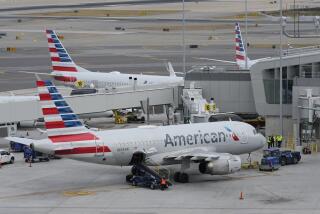Discount airlines may -- or may not -- be going your way
ONE of the cheapest ways to get around Europe these days is aboard one of the growing number of low-fare airlines. A recent count by FlyCheapo.com (www.flycheapo.com), a website that helps travelers find low-fare airlines and the routes they serve, lists 47. Of those, I was familiar with only six and have flown on three — bmibaby, RyanAir and EasyJet.
And although bargains exist, they come with plenty of caveats for American travelers considering using them on their European travels.
For starters, not all airports are served by low-fare carriers. Many fly from smaller, out-of-the-way airports in major cities. For example, RyanAir and EasyJet do not fly from London’s Heathrow Airport, but do fly from Gatwick, Stansted and Luton.
The carriers, for the most part, do not offer connecting service, so bags must be picked up and rechecked if you are making a stop on the way to your final destination. And for destinations off the well-trod path, there may be no service at all.
Virginia Gruwell of Huntington Beach was planning her 25th wedding anniversary trip to Europe this summer and became frustrated when she could not find a low-fare carrier for travel between Nice, France, to Florence, Italy. Her options weren’t looking attractive.
“The train is 11 to 12 hours long, Air Italia is almost $450, one way,” she said in an e-mail to The Times. “We can’t afford the $450-$500 airfare and don’t want the long train ride.”
After looking at FlyCheapo.com, she decided to buy a round-trip ticket from Nice to Florence and use only the first leg. This saved her more than $200. Often, a round-trip is less expensive than a one-way, though the airlines frown on travelers doing this.
If your travel budget includes plans for low-fare carriers in Europe, check to see which airlines serve which destinations. FlyCheapo.com and www.whichbudget.com provide tools to find which — if any — of the myriad low-fare carriers serve the destinations you have in mind.
But flying on some of these airlines comes with the risk that they might not be flying that route or even be in business when you get there.
“The routes change a lot,” said Tom Betts, editor and founder of FlyCheapo.com, which has been around three years. “They have quite a low profit margin, so if a route isn’t profitable, they can cut it without much warning.”
And although many of the airlines are large and well-funded, some of the smaller ones might not be quite as stable.
FlyCheapo.com lists 20 low-fare carriers that are no longer flying, but Betts notes that many were in business for only a few months.
“The European low-cost industry is so fierce and competitive,” Betts said. “The smaller airlines are a bit riskier from the flier’s perspective.”
The best way to keep from losing money if an airline goes under is to purchase your ticket with a credit card, said Martino Matijevic, managing director and founder of WhichBudget .com. In February, his website is launching an airline comparison chart to help travelers familiarize themselves with European low-fare carriers.
The chart is “for an American who has no idea what a Wizz Air is,” he said. (Wizz Air is a Polish low-fare carrier.) It will include information such as safety record, what year the airline started flying, seat pitch and luggage policy. That last item is important because low-fare carriers increasingly are charging to check bags.
Travelers can investigate some of that information by going to the carrier’s website, though Matijevic notes that this information is no guarantee of an airline’s financial health.
If a traveler is stranded by a bankrupt low-fare carrier, competitors sometimes will offer special deals, Betts said.
“The other airline will make a fuss: ‘We’ll rescue their passengers — they can fly on our airline for 10 pounds,’ ” Betts said.
And if all else fails, European trains can still get travelers from Point A to Point B relatively cheaply, if less quickly.
More to Read
Sign up for The Wild
We’ll help you find the best places to hike, bike and run, as well as the perfect silent spots for meditation and yoga.
You may occasionally receive promotional content from the Los Angeles Times.






